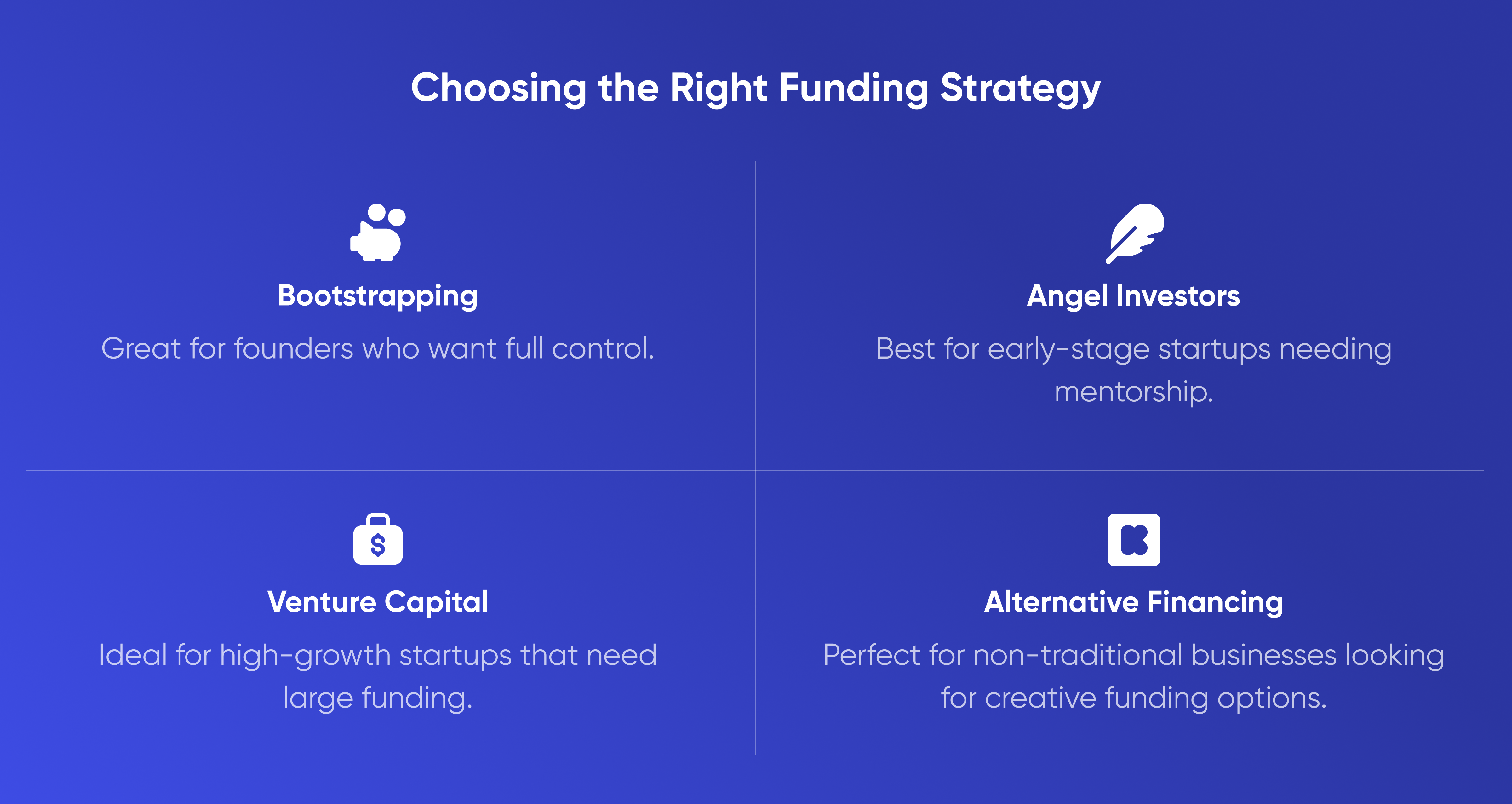Introduction
One of the biggest challenges for entrepreneurs is finding the right funding to turn an idea into a scalable business. Whether you're a tech startup founder, SaaS entrepreneur, or e-commerce business owner, choosing the right financing strategy is crucial for long-term growth and sustainability.
This guide explores the four main ways to fund a startup—bootstrapping, venture capital, angel investors, and alternative financing—to help you find the best option for your business.

1. Bootstrapping: Self-Funding Your Startup
What Is Bootstrapping?
Bootstrapping means building your startup without external investment, relying on personal savings, revenue reinvestment, and lean operations.
Pros of Bootstrapping:
✅ Full ownership & control – No investors mean no equity dilution.
✅ No debt or pressure – You don’t owe anyone money or have to meet investor expectations.
✅ Forces profitability early – You focus on revenue from day one.
Cons of Bootstrapping:
🚨 Slower growth – Limited resources can slow expansion.
🚨 High personal risk – Using personal savings can be financially risky.
🚨 Difficult for capital-intensive startups – If your business requires heavy upfront investment, bootstrapping may not be viable.
💡 Best for: SaaS startups, e-commerce brands, service-based businesses, and small tech startups that can operate lean.
2. Raising Money from Angel Investors
Who Are Angel Investors?
Angel investors are high-net-worth individuals who provide capital to startups in exchange for equity or convertible debt. They typically invest $25,000 - $500,000 in early-stage businesses.
Pros of Angel Investment:
✅ Mentorship & connections – Many angels are experienced entrepreneurs who can provide guidance.
✅ Less formal than VCs – Angel deals are often more flexible.
✅ Quicker access to capital – Compared to venture capital, angel deals close faster.
Cons of Angel Investment:
🚨 Equity dilution – Giving up shares reduces future earnings.
🚨 Less capital than VCs – Angels invest smaller amounts than institutional investors.
🚨 Hard to find – Identifying the right angel investors can take time.
💡 Best for: Early-stage startups with high growth potential, especially in tech, SaaS, and consumer products.
3. Venture Capital: Scaling with Institutional Investors
What Is Venture Capital?
Venture capital (VC) firms provide funding to high-growth startups in exchange for equity. Investments typically range from $500,000 to $100M+, depending on the stage of the startup.
Pros of Venture Capital:
✅ Large capital amounts – VC firms provide significant funding for scaling.
✅ Industry expertise – Many VCs offer strategic advice and network connections.
✅ High credibility – Securing VC funding boosts your startup’s reputation.
Cons of Venture Capital:
🚨 Equity loss & control risks – VCs take ownership stakes and often require board seats.
🚨 Pressure for fast growth – Investors expect high returns and rapid scaling.
🚨 Competitive & selective – Less than 1% of startups get VC funding.
💡 Best for: Tech startups, SaaS companies, fintech, AI, and any venture-scale business with a strong growth trajectory.
4. Alternative Financing: Revenue-Based, Grants, and Crowdfunding
If bootstrapping, angel investment, or VC funding isn’t a fit, consider alternative financing options.
Revenue-Based Financing (RBF):
✅ No equity loss – You repay a percentage of revenue instead of giving up shares.
✅ Best for revenue-generating startups – If you have cash flow, RBF is an option.
Crowdfunding:
✅ Validate market demand – Platforms like Kickstarter and Indiegogo help raise capital while proving customer interest.
✅ No equity required – Backers fund your startup in exchange for early access to your product.
Grants & Competitions:
✅ Non-dilutive funding – You get free money without giving up ownership.
✅ Best for social impact and tech startups – Government grants and startup competitions provide funding to promising ideas.
💡 Best for: Founders looking for equity-free capital or alternative financing structures.
Conclusion: Choosing the Right Funding Strategy
🚀 Best funding strategy depends on your business model, industry, and growth stage.
✅ Bootstrapping – Great for founders who want full control.
✅ Angel Investors – Best for early-stage startups needing mentorship.
✅ Venture Capital – Ideal for high-growth startups that need large funding.
✅ Alternative Financing – Perfect for non-traditional businesses looking for creative funding options.
📩 Need help raising capital for your startup? Movadex specializes in helping founders connect with investors and secure funding.
💡 Book a free consultation today to discuss your startup’s financial strategy!




